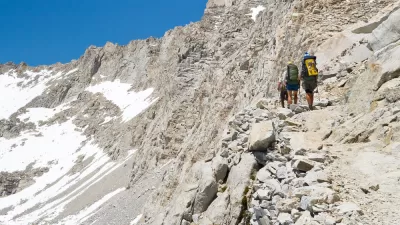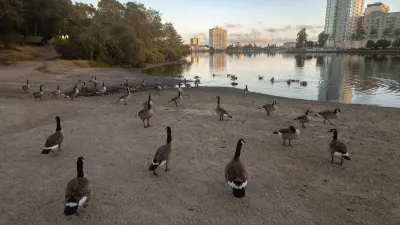This piece from Places delves into the history of the campsite, their use of space, and their role in modern culture.
"This summer millions of Americans will take to the road in search of this powerful experience of nature. And that parcel of land upon which most will elect to drive their car, set up their tent, park their trailer or RV is the campsite - which is thus not only an imagined ideal but also the fundamental unit of management of the modern campground. There are 113,000 federally managed campsites in the United States, 166,000 campsites dispersed across state parks, and untold numbers in private facilities. [3] Last year Kampgrounds of America - KOA, familiarly - alone reported a total usage of over five million campsite nights, as well as 1.5 million hits monthly on its website. [4]
Modern campsites embody a peculiar contradiction: They are defined and serviced by an increasingly sophisticated range of utilities and conveniences, and yet marketed to perpetuate the cherished American ideal of the backwoods camp. For artist Robert Smithson, whose sensitivities to site and site-making were informed by childhood family camping trips he helped organize, the campsite was where one could reenact the making of a place. [5] Campgrounds indeed commodify into multiple sites - literally tens of thousands of them - with each functioning as the locus of a singular experience, which is itself further commodified and mediated by popular imagery. The record sales reported by sporting utility stores like REI and EMS owe largely to the retailers' successful efforts to associate their equipment with the out-of-doors and the prospect of healthy living. For many urbanites, high-performance gear - hiking boots, mountaineering vests, etc. - have become staples of everyday casual chic."
Author Martin Hogue is a fellow at the College of Environmental Forestry at the State University of New York, Syracuse.
FULL STORY: A Short History of the Campsite

Alabama: Trump Terminates Settlements for Black Communities Harmed By Raw Sewage
Trump deemed the landmark civil rights agreement “illegal DEI and environmental justice policy.”

Study: Maui’s Plan to Convert Vacation Rentals to Long-Term Housing Could Cause Nearly $1 Billion Economic Loss
The plan would reduce visitor accommodation by 25% resulting in 1,900 jobs lost.

Planetizen Federal Action Tracker
A weekly monitor of how Trump’s orders and actions are impacting planners and planning in America.

Waymo Gets Permission to Map SF’s Market Street
If allowed to operate on the traffic-restricted street, Waymo’s autonomous taxis would have a leg up over ride-hailing competitors — and counter the city’s efforts to grow bike and pedestrian on the thoroughfare.

Parklet Symposium Highlights the Success of Shared Spaces
Parklets got a boost during the Covid-19 pandemic, when the concept was translated to outdoor dining programs that offered restaurants a lifeline during the shutdown.

Federal Homelessness Agency Places Entire Staff on Leave
The U.S. Interagency Council on Homelessness is the only federal agency dedicated to preventing and ending homelessness.
Urban Design for Planners 1: Software Tools
This six-course series explores essential urban design concepts using open source software and equips planners with the tools they need to participate fully in the urban design process.
Planning for Universal Design
Learn the tools for implementing Universal Design in planning regulations.
Caltrans
Smith Gee Studio
Institute for Housing and Urban Development Studies (IHS)
City of Grandview
Harvard GSD Executive Education
Toledo-Lucas County Plan Commissions
Salt Lake City
NYU Wagner Graduate School of Public Service





























